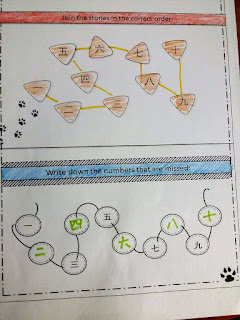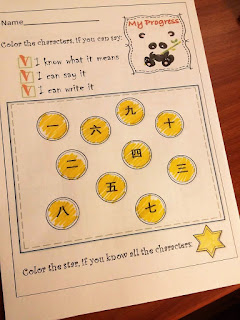First of all, teach according to the age group and level. A teenager will not be interested in counting bugs and circles or sorting things for colors, you might bore to death a 5 year old trying to explain grammar constructions. Make the lessons engaging and fun, but do it accordingly. When kids play, they learn much more and much faster, you just need to follow their interests.
Second, comes the systematic approach. There should always be a system, a plan. I do lists with vocabulary, grammar, speaking constructions, topics for a year, half a year, three months, month, week... And, of course, lesson plans. Plenty of them. I often might change the daily and weekly plans because even though in the beginning of the year you think, that the plan is perfect (and it never is) real life would always make changes or rearrange the order.
Third, track the progress. I would make my own progress reports, which I track, and progress reports made by kids themselves to track their own progress. These reports and interactive notebooks keep students motivated and their parents updated.
Speaking.
There have been many arguments whether you should use the mother language or just make the lesson completely in Chinese.
I have mixed feelings about it. I think it is fine with small kids age 5-9. If the child is 10 or up, it might not be the best idea to abandon the mother language or the other language they are familiar with.
Because of the topics, vocabulary and constructions, sometimes you just need to explain something that is beyond the flashcards, especially the grammar part. Forcing older kids to communicate at the level of babies is an interesting experiment, but not on a constant basis.
With smaller kids, I try to speak only in Chinese. I do believe in Communicative language teaching (CLT) over grammar drills and memorization, but I prefer to get the best out of all methods.
With older groups, I do not abandon the mother language completely, and while trying to give simple instructions in Chinese would use their language to explain grammar or something that I want to be sure everyone would understand completely.
I think everything is good in moderation. And I do make kids write characters and learn grammar constructions. I will write another post on writing and grammar.
What is CLT?
Language learners in environments utilizing CLT techniques, learn and practice the target language through the interaction with one another and the instructor, the study of "authentic texts" (those written in the target language for purposes other than language learning), and through the use of the language both in class and outside of class.
According to CLT, the goal of language education is the ability to communicate in the target language. I love the idea, that the teacher is being a facilitator, rather than an instructor.
Bring visuals. Kids are visual creatures, so it is always good to bring some visuals. Flashcards are great, but some real objects (maps, toys, puzzles, stickers, brushes, coins, even subway cards) always bring more excitement to the classroom.
Here are some ideas to encourage more speaking in the classroom:
Making Sentences with new words. Making silly sentences.
Association games. Someone starts, then others say whatever association comes to mind, then the third person says what came to mind on the second word like
苹果-红色-中国-人-多-菜-饿。。。
Word maps with as many associations on one word as you can, like
家 = 爸爸,妈妈,奶奶, 吃饭,睡觉,玩儿电脑 。。。 =)
great way to check the vocabulary and even enlarge it, cause kids would want to say something they don't know.
Showing one of the learned words without words or sounds, while others try to guess the word.
Role-play with costumes or in simple decorations is always a fun way to practice new expressions. It is a fun even without decorations.
Kids can even make a play (or even create their own) and then invite their parents to watch it. I do invite the parents sometimes so the kids can show off the play or the song or dance to a wider audience.
Interview and social surveys, with tables and graphs to fill in. After the surveys filled in, they will have to tell in full sentences all the information written.
Discussions on the topic.
It is always good to implement some speaking routine. For example, I always ask kids to tell me the date, day of the week and the weather outside.
My partner teacher, that we worked together in China came up with the idea of making votes before the lesson. Every morning before the assembly we had votes for the mini teacher (helps the teacher), language police(makes sure everyone speaks the targeted language), the leader (goes first in the line and reads the school pledge during morning assembly ) and vice leader(goes last in the line, whenever class goes outside the classroom and keeps the order in the line).
Those who want to get one of those duties would one by one come to the board and explain why other kids would need to vote for them and why they are suitable for it.
There were just simple phrases like – I want to be a mini teacher, because I would help teacher to deliver notebooks, ad clean the whiteboard and close the door and open windows or anything they can come up with. That was adorable. After all the speeches, everyone would close the eyes and we would ask - who wants XX to be a mini teacher raise your hand. Repeat until all the volunteers mentioned. Then everyone would open the eyes and see the results of the votes. We would count the votes together and announce who got the position for the day.
Scavenger Hunts are great for speaking and are always an exciting event. I am a fan of Alias game, so want to try to make task cards in Chinese to try in class. Unfortunately, I only have small groups now an do it in the format of a language course, but I think it can also be exciting to try even with a small group.
"Fieldwork". Not the actual fieldwork. When the topic is familiar students are encouraged to make their own research to find additional information and then present it to class.
I give special stickers for extra tasks being done and take them away for not doing the homework or not complying with class rules. If any of the student would manage to collect 15 stickers, he or she can become a teacher for 15 minutes out of the lesson. I tried many rewards, but this one is the most desirable reward, so since it works best with kids I stick to it. Also being a teacher even for 15 minutes is not only exciting but teaches them that being a teacher is not easy.
Short poems, tongue-twisters, counting rhymes, riddles, play paper scissors in Chinese and other simple games like red - stop, green- go, Simon says, Hangman, and so on.
Make a competition with another class, kids love small competitions. We play desk partner against desk partner, girls against boys, one team against the other, or very rarely one class against the other.
Create your own games.
Learn a dance, with the instructions in a targeted language. Or just find the video in Chinese with the instruction on how to dance.
https://www.youtube.com/watch?v=BPiXXXOxhOs&t=55s
Watch short cartoons, sing songs. Songs though are tricky, when the kids are a little older they might go against singing in class, so it really depends on the kids.
https://www.youtube.com/watch?v=N8jeTuHX9-U
Crafts. While making crafts they will have to listen to the instruction given in Chinese and be on their best behaviour, otherwise, it will be another exercise.
In the very end of the lesson, kids would say what they’ve learned, I would usually write a short summary on the whiteboard based on their answers.
Sometimes, I don’t always have enough time, we pass the ball or a pen, or any object and one by one the kid would shortly say, what was fun, what was difficult and why, and what he\she would like to do more or change next time.
I got some great ideas from the kids, and that is a way to get a fair feedback. This part I’m guilty is not in Chinese, but rather in their own language. But at least we review what we’ve studied and kids feel that their opinion matters.
How do you encourage speaking and using Chinese or English (if English is not their mother language) in the class? What works best for your students?


































